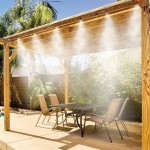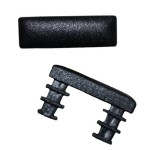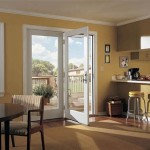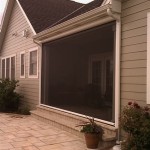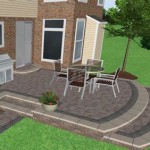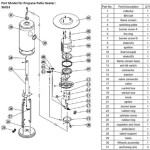Patio Heater Electric Wall Mounted: An In-Depth Guide
Electric wall-mounted patio heaters provide an efficient and space-saving solution for extending the usability of outdoor spaces during cooler months. These devices offer targeted warmth, convenient operation, and a range of features that make them a popular choice for both residential and commercial settings. This article comprehensively examines the benefits, types, installation considerations, and maintenance aspects of electric wall-mounted patio heaters.
Benefits of Electric Wall-Mounted Patio Heaters
Electric wall-mounted patio heaters present several advantages over other heating options, such as propane-fueled heaters or freestanding electric models. The key benefits include space efficiency, ease of use, environmental friendliness, and cost-effectiveness. These factors contribute to their increasing adoption in diverse environments.
Space Efficiency: One of the primary benefits of wall-mounted heaters is their ability to conserve valuable floor space. Unlike freestanding heaters, which require a substantial footprint, wall-mounted units are affixed to a wall or other vertical surface, leaving the ground area clear for furniture, walkways, and other uses. This makes them especially suitable for smaller patios, balconies, and outdoor dining areas where space is at a premium.
Ease of Use: Electric patio heaters are generally straightforward to operate. Most models come with simple controls, such as on/off switches or remote controls that allow users to adjust the heat output from a distance. Unlike gas-powered heaters, electric models do not require the refueling of propane tanks, eliminating a significant logistical concern. The convenience of electric operation contributes to a hassle-free user experience.
Environmental Friendliness: Compared to propane heaters, electric patio heaters produce no direct emissions. They rely on electricity as their power source, which can be generated from renewable resources such as solar, wind, or hydroelectric power. By opting for electric heating, users can reduce their carbon footprint and contribute to a more sustainable environment. This aspect is increasingly important to environmentally conscious consumers and businesses.
Cost-Effectiveness: While the initial purchase price of an electric wall-mounted patio heater may be comparable to or slightly higher than other heating options, the long-term operating costs can be significantly lower. Electric heaters do not require the ongoing expense of propane refills, and they often feature energy-saving technologies such as adjustable heat settings and timer functions. These features allow users to optimize energy consumption and minimize electricity bills.
Types of Electric Wall-Mounted Patio Heaters
Electric wall-mounted patio heaters are available in various types, each utilizing different heating technologies and offering distinct performance characteristics. The most common types include infrared heaters, halogen heaters, and quartz heaters. Understanding the differences between these types is crucial for selecting the most suitable heater for a specific application.
Infrared Heaters: Infrared heaters are among the most popular and efficient types of electric patio heaters. They emit infrared radiation, which directly heats objects and people within their range, rather than heating the surrounding air. This makes them particularly effective in outdoor environments where wind and air currents can dissipate heat quickly. Infrared heaters provide instant warmth and are less affected by ambient temperature than other types of heaters. Within the infrared category, there are further subdivisions based on the wavelength of the emitted radiation: short-wave, medium-wave, and long-wave. Short-wave infrared heaters produce intense heat and are suitable for larger areas, while medium-wave and long-wave heaters offer more gentle heat and are better suited for smaller, enclosed spaces.
Halogen Heaters: Halogen heaters utilize halogen lamps to generate heat. They provide a bright, intense light along with warmth. Halogen heaters are known for their rapid warm-up time and high heat output. However, they can be less energy-efficient than infrared heaters and may produce a glare that some users find uncomfortable. Halogen heaters are typically used in commercial settings where a high level of heat and visibility is required, such as outdoor bars and restaurants.
Quartz Heaters: Quartz heaters use quartz tubes containing a heating element. They produce a softer, more diffused heat than halogen heaters and do not emit as much light. Quartz heaters are a good compromise between infrared and halogen heaters, offering a balance of efficiency, heat output, and comfort. They are often used in residential patios and balconies where a more subtle heating solution is desired.
When selecting a type of electric wall-mounted patio heater, it is essential to consider the size of the space to be heated, the desired level of warmth, the energy efficiency of the heater, and any specific requirements such as glare reduction or rapid warm-up time. Each type of heater offers a unique set of advantages and disadvantages that should be carefully evaluated to ensure optimal performance and user satisfaction.
Installation Considerations for Electric Wall-Mounted Patio Heaters
Proper installation is crucial for the safe and effective operation of electric wall-mounted patio heaters. Incorrect installation can lead to safety hazards, reduced performance, and premature failure of the heater. Several factors must be considered during the installation process, including location, electrical requirements, mounting hardware, and safety regulations.
Location: The location of the patio heater should be carefully chosen to maximize its heating effectiveness and minimize potential hazards. The heater should be mounted in a location that provides optimal coverage of the area to be heated, taking into account the heater's range and angle of projection. It should also be positioned away from flammable materials such as curtains, foliage, and wooden structures. The mounting location should be easily accessible for maintenance and cleaning.
Electrical Requirements: Electric patio heaters require a dedicated electrical circuit with sufficient amperage to handle their power consumption. Before installation, it is essential to verify that the electrical system can support the heater's electrical load. A qualified electrician should be consulted to ensure that the electrical wiring is properly sized and grounded, and that a suitable circuit breaker is installed. Some heaters may require a 240-volt electrical connection, while others can operate on a standard 120-volt circuit. It is crucial to follow the manufacturer's instructions and local electrical codes to ensure a safe and compliant installation.
Mounting Hardware: The mounting hardware used to secure the patio heater to the wall or ceiling must be strong enough to support the weight of the heater and withstand wind and other environmental factors. The hardware should be made of durable, weather-resistant materials such as stainless steel or galvanized steel. The mounting surface should be solid and stable, such as concrete, brick, or reinforced wood. If mounting to a hollow wall, it may be necessary to use specialized anchors to provide adequate support. The installation instructions provided by the manufacturer should be carefully followed to ensure that the heater is securely mounted.
Safety Regulations: Installation of electric patio heaters must comply with all applicable safety regulations and building codes. These regulations may specify minimum clearances from combustible materials, requirements for electrical grounding, and other safety measures. It is the responsibility of the installer to ensure that the installation meets all applicable requirements. Failure to comply with safety regulations can result in fines, property damage, and personal injury. Consulting with a licensed electrician and building inspector can help ensure a safe and compliant installation.
In addition to these considerations, it is important to follow the manufacturer's instructions carefully during the installation process. The instructions provide specific guidance on mounting height, wiring connections, and other critical aspects of the installation. Adhering to the manufacturer's instructions will help ensure that the heater operates safely and efficiently for many years.
The power output of electric wall-mounted patio heaters, typically measured in watts or kilowatts, directly influences the amount of heat generated and the area it can effectively warm. Selecting the appropriate power output is crucial for ensuring adequate heating without unnecessary energy consumption. Heaters with higher wattage ratings produce more heat and can cover larger areas, but they also consume more electricity. Lower wattage heaters are more energy-efficient but may not provide sufficient warmth in larger or more exposed areas.
The size and layout of the patio or outdoor space should be considered when determining the required power output. Larger patios generally require higher wattage heaters, while smaller balconies or enclosed spaces may be adequately heated by lower wattage models. The climate and typical weather conditions in the area also play a role. Colder climates or areas with frequent wind exposure may necessitate higher wattage heaters to compensate for heat loss. The desired level of warmth is another factor to consider. Some users may prefer a more intense heat output, while others may be content with a gentler warmth. Adjustable heat settings allow users to customize the heat output to their preferences and the prevailing weather conditions.
As a general guideline, manufacturers often provide recommendations for the appropriate wattage based on the square footage of the area to be heated. These recommendations can serve as a starting point, but it is important to consider the other factors mentioned above when making a final decision. It is also worth noting that multiple smaller heaters may be more effective than a single large heater, particularly in oddly shaped or complex outdoor spaces. Multiple heaters can provide more even heat distribution and allow for localized temperature control.

Wall Mounted Patio Heaters From Herschel Stylish Outdoor

Omcan 31432 Wall Mount Electric Outdoor Patio Heater 120v 1500w

Wall Mounted Electric Patio Heaters Infrared Direct

Wall Mounted Patio Heaters From Herschel Effective Outdoor Heat

Electric Wall Mounted Patio Heater Dunelm

Original Sunheat Commercial Electric Wall Or Tripod Mounted Patio Heater With Remote Black

Wall Mounted Patio Heaters Electric Heat Outdoors

Wall Mounted Patio Heater 2500w Electric Infrared On Off Switch Control Ebay

Limitless Wall Mounted Electric Patio Heater Electrical World
Wall Mounted Heatup Patio Heater Electric
See Also

